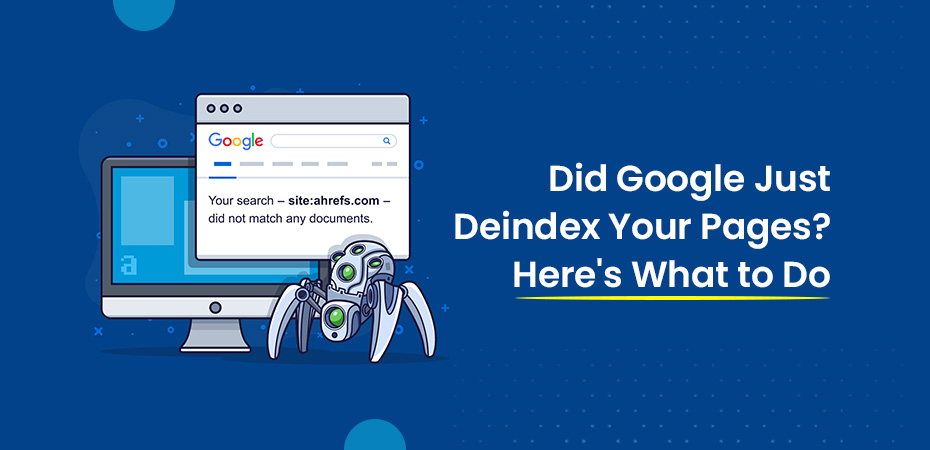Did Google Just Deindex Your Pages? Here’s What to Do



Google is deindexing pages – what’s the impact? And how to fix it? Deindexing refers to the removal of web pages from Google’s search index, meaning they no longer appear in search results. This process plays a crucial role in SEO as it directly affects a website’s visibility.
Understanding the reasons behind Google deindexing and knowing how to address these issues is vital. Pages can be deindexed due to factors like manual actions, algorithm updates, technical issues, low-quality content, or intentional use of ‘noindex’ tags.
When Google deindexes pages on your site, it can result in:
- A sudden drop in organic traffic
- Significant fluctuations in keyword rankings
Ensuring that your website remains indexed is essential for maintaining its presence and performance in search results.
Understanding Google Deindexing
What is Deindexing?
De-indexing means removing web pages from Google’s search index, making them invisible in search results. This process is part of Google’s larger system where it scans and indexes web pages to assess their relevance and quality. Once a page is deindexed, it’s no longer part of this searchable collection.
Why Does Google Deindex Pages?
There are several reasons related to deindexing a page from google:
- Manual Actions: Google might manually remove pages that break its rules.
- Algorithm Updates: Changes in Google’s algorithms can lead to the removal of certain pages if they don’t meet the new quality standards.
- Low-Quality Content: Pages with little or copied content often get removed as they don’t offer much value to users.
- Technical Problems: Issues like server errors or wrong redirects can cause pages to be taken out of the index.
- Use of ‘Noindex’ Tags: Adding ‘noindex’ tags to pages, either on purpose or by mistake, will tell Google not to include those pages in its index.
Knowing these reasons is essential for keeping your website visible and making sure your important content stays in search results.
How Deindexing Affects Your Website
When pages on your website are deindexed, they no longer show up in Google’s search results. This can lead to a sudden drop in organic traffic, which can be especially harmful for websites that depend on search engines to bring in visitors and potential customers.
What Happens When You Lose Indexed Web Pages on Google
- Less Organic Traffic: When pages are deindexed, they’re removed from search results. This means people searching for related keywords won’t find your content, leading to a significant drop in organic traffic.
- Lower Visibility: With fewer pages being indexed by Google, your website’s presence in search results decreases. This makes it harder for new users to find your site, affecting brand awareness and growth.
Changes in Keyword Rankings
Deindexed pages can cause major shifts in keyword rankings leading to an eventual drop of your website pages from Search Engine Result Pages. When important pages are removed from Google’s index, the keywords associated with them lose their positions in search results. This can disrupt your entire SEO strategy:
- Keyword Ranking Drops: Keywords linked to deindexed pages may fall drastically in rankings or disappear completely from search results. This affects your site’s ability to attract targeted traffic through those keywords.
- Overall SEO Strategy: A successful SEO strategy depends on stable keyword rankings and consistent visibility. Deindexing throws off this balance, requiring immediate action to identify and fix the issues causing deindexation.
Understanding these effects is essential for maintaining a strong online presence. Identifying and fixing deindexing problems quickly ensures that your website continues to perform well in search engine rankings. It’s crucial to recognize the Google ranking factors that influence your website’s visibility and take necessary steps to align with them.
Diagnosing Indexing Problems with Google Search Console
Google Search Console is a valuable tool for checking Google page indexing issues and finding out why Google might be removing pages from your website. This tool shows you which pages are indexed, which aren’t, and highlights any errors that could be causing deindexing.
Step-by-Step Guide to Check Indexed Pages and Errors
Following are the steps useful for finding indexed pages in Google and errors as well:
- Access Google Search Console: Go to Google Search Console and log in with your credentials.
- Select Your Property: Choose the relevant website property from the list of verified properties in your account.
- Inspect a URL: Use the URL Inspection Tool to check the status of specific URLs. Enter a URL from your domain and press enter. The tool will show if the page is indexed or if there are issues preventing it from being indexed.
- Check Index Coverage Report: Go to the Coverage section under the Index tab. Review the report to identify which pages are indexed, which have errors, and which are excluded. Pay close attention to errors such as “Crawled – currently not indexed”, “Discovered – currently not indexed”, or any other issues listed.
- Analyze Error Details: Click on any error type to see detailed information about affected pages. Identify common problems such as server errors (5xx), not found (404), or blocked by robots.txt.
- Resolve Issues: Address each issue based on the error type—modify meta tags, update robots.txt, fix server issues, or remove ‘noindex’ tags where necessary.
By systematically using Google Search Console, you can diagnose and address indexing problems efficiently, ensuring better visibility for your web pages in search results.
Once you’ve fixed the issues, it’s essential to understand how often Google reindexes your pages. While there’s no set timeframe, reindexing can occur more frequently if your website is updated regularly or if you’ve requested manual reindexing through Google Search Console.
Fixing Deindexing Issues: Step-by-Step Guide
Repairing deindexed pages requires a systematic approach and attention to detail. Here’s how to fix deindexing issues and reindex on Google:
Check Meta Tags
Inspect your HTML for the <meta name=”robots” content=”noindex”> tag. Remove this tag if it is unintentionally included on important pages.
Review Canonical Tags
Ensure proper use of canonical tags (<link rel=”canonical” href=”URL”>). Incorrect canonicalization can mislead Google into ignoring the actual page you want indexed.
Ensure Proper Redirects
- Verify that 301 redirects are correctly set up when pages are moved or deleted. Misconfigured redirects can result in deindexed pages.
- Use tools like Screaming Frog to crawl your site and identify redirect issues.
Update XML Sitemap
Regularly update and submit your XML sitemap via Google Search Console. This helps guide Google to the correct pages for indexing.
Review Robots.txt File
Check your robots.txt file for any disallowed directives that might block search engines from crawling your website’s important sections.
Address Technical Issues
Optimize page load times and fix server errors (e.g., 404s, 500s) to ensure a smooth crawl process by search engines.
Request Manual Google Reindexing
Use the URL Inspection Tool in Google Search Console to request reindexing of pages that were mistakenly deindexed.
By addressing these key areas, you can effectively resolve issues with deindexed pages and improve your site’s visibility on Google.
Optimizing Content and Technical Configuration for Better Indexability
Strategies for Creating High-Quality Content
Having high-quality content for SEO is crucial in ensuring your pages get indexed by Google. Search engines prioritize content that is:
- Relevant: Address the search intent of users effectively.
- Informative: Provide comprehensive, well-researched information.
- Engaging: Use multimedia elements like images, videos, and infographics to enhance user experience.
- Original: Avoid duplicate content which can lead to deindexing.
Regularly updating your content also signals to search engines that your website is active and fresh, encouraging more frequent indexing.
Techniques to Enhance Technical Performance
Improving page load time is another significant factor for better indexability. Slow-loading pages can lead to higher bounce rates, negatively impacting your site’s SEO. Consider implementing these techniques:
- Optimize Images: Compress images without sacrificing quality to reduce load times.
- Leverage Browser Caching: Enable caching so returning visitors face shorter loading times.
- Minimize HTTP Requests: Streamline the number of elements on a page to decrease loading time.
- Use a Content Delivery Network (CDN): Distribute content through various servers globally to speed up delivery times.
Ensuring your website’s technical configuration aligns with best practices makes it easier for search engines like Google to crawl and index your pages efficiently.
When to Seek Professional Help for Deindexing Issues?
Knowing when to reach out to an SEO agency or a content marketing agency can make a big difference in solving complex deindexing problems.
Here are some situations where you might need professional help:
- Technical Configurations: If you’re dealing with complicated issues involving robots.txt files, canonical tags, and XML sitemaps, it’s best to get an expert involved for proper implementation.
- Content Strategies: If your content isn’t getting indexed or staying visible, a content marketing agency can create high-quality, SEO-friendly content specifically for your needs.
- Persistent Issues: When you’ve tried fixing deindexing problems using standard methods but haven’t seen results, professionals can identify and fix underlying issues.
Handling these details effectively ensures that your pages stay indexed and maintain your website’s search engine performance.
Conclusion: Taking Control of Your Website’s Indexability
Taking control of your website’s indexability is crucial for maintaining visibility in search engine results. Regularly monitoring your site’s indexing status and learning about SEO best practices can help prevent issues related to deindexing.
- Proactive Monitoring: Utilize tools like Google Search Console to keep tabs on any page indexing issues detected. This helps you quickly address potential problems before they impact on your organic traffic.
- Stay Informed: Continuously educate yourself on the latest SEO trends and updates. Understanding why Google might deindex pages, such as through the use of ‘noindex’ tags or low-quality content, allows you to make informed decisions that support your site’s performance.
By staying proactive and informed, you’ll be better equipped to handle situations where Google is deindexing pages and ensure your content remains visible and effective in driving traffic.